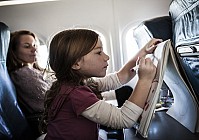We are all familiar with the standard in-flight announcement telling us to switch off all electronic devices, but with the US government moving toward allowing the use of everything from smartphones to laptops at take-off and landing – this could soon be a thing of the past.
As part of the US Department of Transportation, the Federal Aviation Administration (FAA) will be taking advice from the Aviation Rulemaking Committee in September, when the motion to ease current restrictions is expected to pass.
The committee is currently investigating existing policies to determine when portable electronic devices can be safely used during flight.
It is suspected that the decision to reconsider regulations has been prompted by increasing public pressure. A much larger number of people are using e-readers, tablets and laptops when they fly and passengers are taking less kindly to being disrupted when they are unsure of the safety benefit.
“The FAA recognizes consumers are intensely interested in the use of personal electronics aboard aircraft; that is why we tasked a government-industry group to examine the safety issues and the feasibility of changing the current restrictions," the agency said in a statement.
Existing rules and regulations state that passengers should turn off tablets, e-readers and any other portable electronic devices (PEDs) with an “off” switch when the aircraft is below 10,000ft.
This is to prevent potential interference caused by devices operating on the same frequency as the plane’s sensitive communications, navigation, flight control and electronic equipment.
However, there is no way of knowing whether electronic equipment poses any real threat without the individual testing of every PED on the market. The Aviation Rulemaking Committee is currently determining which technologies can be used.
The FAA has stated that some rules will not change – passengers will still be unable to make voice calls in-flight, as it remains prohibited by the Federal Communications Commission.









